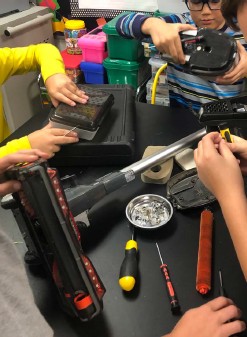STEM Sparks: March 2025
STEM Practices that Promote 21st Century Outcomes
 As an elementary classroom teacher, implementing integrated STEM education into instructional practices may seem like a daunting task, but achieving 21st century learning skills is worth the time and effort. Much of the content students learn through integrated STEM lessons and activities transfers to other core content areas (Kelley & Knowles, 2016). When students practice solving technical problems through STEM activities and challenges, they establish critical communication skills, identify flexible problem-solving strategies, and they develop grit or a growth mindset! These are the skills that students urgently need to be successful and STEM-capable in the future workforce (Pearson, 2017). By completing numerous integrated STEM problem-solving experiences, students will transfer important learned skills and practices to other projects, other classes, and to other life experiences.
As an elementary classroom teacher, implementing integrated STEM education into instructional practices may seem like a daunting task, but achieving 21st century learning skills is worth the time and effort. Much of the content students learn through integrated STEM lessons and activities transfers to other core content areas (Kelley & Knowles, 2016). When students practice solving technical problems through STEM activities and challenges, they establish critical communication skills, identify flexible problem-solving strategies, and they develop grit or a growth mindset! These are the skills that students urgently need to be successful and STEM-capable in the future workforce (Pearson, 2017). By completing numerous integrated STEM problem-solving experiences, students will transfer important learned skills and practices to other projects, other classes, and to other life experiences.
The authors have shared implementation strategies that have been identified as effective techniques for integrating STEM practices into elementary classroom experiences while building 21st century learning and workforce skills.
Teamwork
While it may seem cliché, teamwork is the linchpin to 21st century learning and skill development (Cleaves, 2015). Without the ability to learn from others, accept differences, voice ideas, utilize skills flexibly, and develop ideas within a team structure, the true opportunity for STEM practices may be lost. Working as a member of a team forces students to think about their peers’ solutions and the ideas of others, rather than simply focusing on their own initial ideas (Cleaves, 2015).
Simple Challenges
Kaufman (2013) notes that the push for 21st century skills is not a new concept, but rather a goal to better
prepare students for the rapidly changing world. She suggests that regularly challenging students to engage in critical thinking and ill-structured problem solving is a critical element (Kaufman). Advancing critical-thinking skills doesn’t necessarily imply introducing massive STEM challenges that require large amounts of time and resources—although those are exciting as well. Short-term STEM challenges provided a few times each week can introduce STEM problem solving as a natural part of classroom routines and assist in the development of a classroom culture of critical thinking and collaborative problem solving.
Growth Mindset
Not only do STEM challenges help students develop and transfer knowledge, but they also create opportunities for students to develop a growth mindset. A growth mindset implies that students understand
that learning and skill development include both successes and setbacks, but are both an essential part of the learning process (Dweck 2017).
Take-apart Lab: Tinkering
Giving students the time to tinker and explore helps them discover and become curious about how things
work and is another useful tool that assists students in achieving 21st century learning skills. Teachers can use a take-apart lab to build curiosity and the willingness to tinker and explore within their students.
Integrated STEM Approach/Real World Issues
Students are engaged and more motivated to learn when real-world issues are connected to the content
in an integrated approach (Pearson, 2017). The integration of content from differing disciplinary areas mirrors the world outside the classroom and can assist students in making connections between discrete content
areas (Kelley & Knowles, 2016).
Children’s Literature
Children’s literature plays an important role in the integrated STEM classroom and provides another avenue for delivering 21st century learning skills.
Interested in more about STEM Practices that Promote 21st Century Outcomes? Read the full article by Lisa Taylor and Michael K. Daugherty in the September 2024 issue of Technology and Engineering Education.
ITEEA Members receive a complimentary electronic subscription to TEE.
Not a member? Join today at https://www.iteea.org/membership
